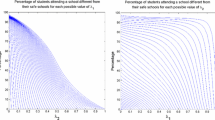Abstract
School districts commonly ration public school seats based on students’ preferences and schools’ priorities. Priorities reflect the school districts’ objectives for reducing busing costs (walk-zone priority) or utilizing siblings’ learning spillovers (sibling priority). I develop a simple modification of the well-studied Top Trading Cycles mechanism that matches schools to higher priority students while preserving the mechanism’s desirable efficiency and incentives properties.

Similar content being viewed by others
Notes
The assumptions that there are equal number of students and school seats and that all schools are acceptable is without loss of generality; we can introduce additional schools that represent being unassigned, and additional students who prefer to be unassigned and the arguments would carry through.
Hatfield et al. (2016) prove the result in their Supplementary Appendix (Proposition 9). The intuition behind the result is that when a student’s priority rank is reduced (improved), she is pointed by less (more) schools, either directly or indirectly. Hence, she can ‘afford’ less (more) schools under the TTC after the reduction (improvement).
Since the average number of justified-envy instances is the same under TTC and TTC-R, the two mechanisms are also not comparable with respect to the justified-envy comparison notion in Abdulkadiroğlu et al. (2020).
I thank an anonymous reviewer for highlighting this shortcoming of TTC-R.
For the sake brevity, a transposition is given only by mentioning which elements are swapped.
References
Abdulkadiroğlu A, Sönmez T (2003) School choice: a mechanism design approach. Am Econ Rev 93:729–747
Abdulkadiroğlu A, Che Y-K, Pathak P, Roth A, Tercieux O (2020) Efficiency, justified envy, and incentives in priority-based matching. Am Econ Rev Insights
Abdulkadiroğlu A, Dur U, Grigoryan A (2021) School choice with match quality. National Bureau of Economic Research, Working Paper No 28512
Balinski M, Sönmez T (1999) A tale of two mechanisms: student placement. J Econ Theory 84:73–94
Che Y-K, Tercieux O (2017) Top trading cycles in prioritized matching: an irrelevance of priorities in large markets. Manuscript. Columbia Univ. and Paris School Econ
Dur U, Kominers SD, Pathak PA, Sönmez T (2018) Reserve design: unintended consequences and the demise of Boston’s walk zones. J Polit Econ 6:2457–2479
Dur U, Morrill T, Phan W (2021) Family ties: school assignment with siblings. Theor Econ
Gale D, Shapley LS (1962) College admissions and the stability of marriage. Am Math Mon 69:9–15
Hakimov R, Kesten O (2018) The equitable top trading cycles mechanism for school choice. Int Econ Rev 59:2219–2258
Hatfield JW, Kojima F, Narita Y (2016) Improving schools through school choice: a market design approach. J Econ Theory 166:186–211
Menino T (2012) Recommendation to implement a new BPS assignment algorithm, State of the City, January 17. http://www.cityofboston.gov/
Morrill T (2015) Two simple variations of top trading cycles. Econ Theor 60:123–140
Shapley L, Scarf H (1974) On cores and indivisibility. J Math Econ 1:23–28
Shi P (2021) Optimal priority-based allocation mechanisms. Manag Sci
Acknowledgements
I thank the participants of the 2019 Conference on Economic Design for helpful discussions. I also thank two anonymous reviewers for valuable suggestions and comments.
Author information
Authors and Affiliations
Corresponding author
Additional information
Publisher's Note
Springer Nature remains neutral with regard to jurisdictional claims in published maps and institutional affiliations.
Appendix A
Appendix A
1.1 A.1 Proof of Lemma 1
It is sufficient to restrict attention to one school \(s \in S\) and show that the desired permutation on \(\{1,2,\ldots ,q_s\}\) can be achieved by a product of transpositions, where a transposition is a permutation that changes the position of only two elements.
Let \(\lambda \) be an arbitrary permutation of \((1,2,\ldots ,q_s)\), e.g. one corresponding to the restriction of an arbitrary reordering \(\pi \) on school s. It is sufficient to find permutations \((\lambda _{j})_{j=1}^{q_s}\) such that for each \(n \in \{1,2,3,\ldots ,q_s\}\) the following conditions are satisfied:
-
1.
\(\lambda _n\) is a product of transpositions,
-
2.
\(\lambda _{n}^{-1}(k) = \lambda ^{-1}(k)\) for all \(k \in \{q_s - n + 1, q_s -n + 2, \ldots , q_s\}\),
-
3.
for each \(m, l \in L_n := \big \{ \lambda ^{-1}(1), \lambda ^{-1}(2), \ldots , \lambda ^{-1} (q_s - n) \big \}\) we have
$$\begin{aligned} m \le l \iff \lambda _{n}(m) \le \lambda _{n}(l), \end{aligned}$$i.e., \(L_n\) preserves order under \(\lambda _n\).
We construct such permutations inductively. First, observe that \(m_1 := \lambda ^{-1}(q_s) \le q_s\). If \(m_1 = q_s\), then setting the \(\lambda _n\) being the identity permutation satisfies the desired conditions. Now assume \(m_1 < q_s\). Consider the set of transpositions \((\lambda ^{j,1})_{j = 0}^{q_s - m_1-1}\) given by \(\lambda ^{j,1}(m_1+j) = m_1+j+1\)Footnote 5. Let \(\lambda _{1} := \times _{j =0}^{q_s - m_1-1} \lambda ^{j,1}\). Then, \(\lambda _{1}\) satisfies the desired conditions. Now suppose \((\lambda _j)_{j=1}^{n-1}\) satisfy the desired conditions. Let \(m_{n} := \lambda ^{-1}(q_s - n+1)\) and let \(l := \lambda _{n-1} (m_n)\). Since the elements in \(L_{n-1}\) preserve order under \(\lambda _{n-1}\), we get \(l \le \lambda _{n-1}^{-1}(q_s - n +1)\). Consider transpositions \((\lambda ^{j,n})_{j=0}^{q_s - l -n}\) given by \(\lambda ^{j,n}(l+j) = l+j + 1\). Then, \(\lambda _{n} = \lambda _{n-1} \times \big ( \times _{j =0}^{q_s - l -n} \lambda ^{j,n} \big )\) satisfies the desired conditions.
Rights and permissions
About this article
Cite this article
Grigoryan, A. Top trading cycles with reordering: improving match priority in school choice. Soc Choice Welf 60, 383–396 (2023). https://doi.org/10.1007/s00355-022-01422-6
Received:
Accepted:
Published:
Issue Date:
DOI: https://doi.org/10.1007/s00355-022-01422-6



